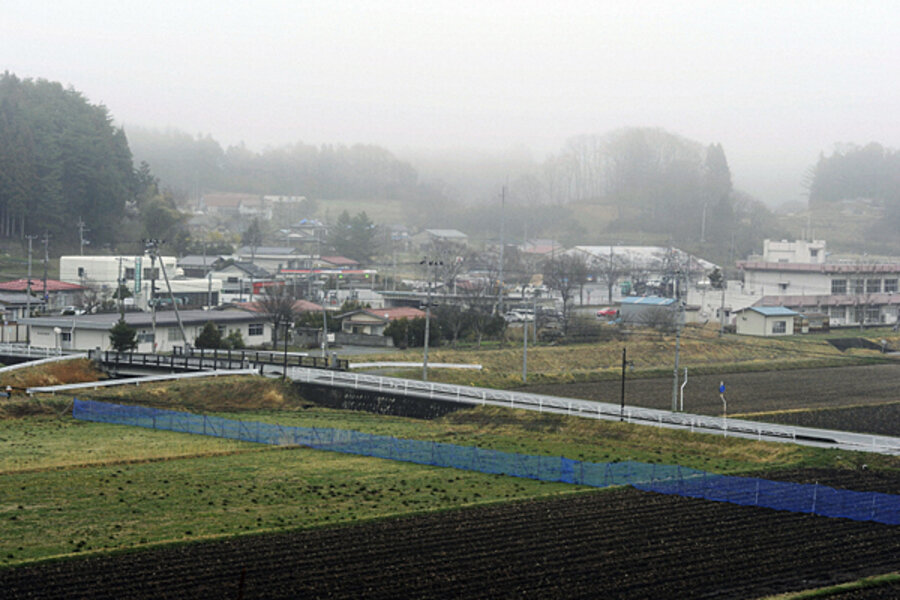Japan after Fukushima: village of nuclear evacuees forced to start over - again
Loading...
| Iitate, Japan
Miyuki Ichisawa and her husband, Shukoh, started a European-style cafe 20 years ago in this sleepy mountainous village in northeastern Japan. It was a bit of a gamble: Iitate was beautiful, but it was one of the area's poorest villages.
“We opened the cafe on this land because we wanted more people to visit the village,” Mrs. Ichisawa recalls. Despite the fierce objections of family members and friends, Shukoh, a sixth-generation farmer, quit his civil-service job and decided to run “Agri” while trying to revive his family farm.
To his family's surprise, not only did the cafe draw many customers, but over time, the village began to shift from one of Fukushima Prefecture's poorest to a quaint getaway in the mountains. It was also a champion of the region's organic agriculture. The village's transformation was bolstered by its decision to join Japan's "most beautiful villages" union. Part of a push by Japan to position itself as a leader in the world's urgent quest to live greener, the organization was started in 2005 with seven villages and the goal of preserving the natural environment and sustaining forgotten, struggling villages.
But the Ichisawas' business came to a screeching halt in March – just after Mr. Ichisawa finished planting 1,000 blueberry bushes around their cafe. A magnitude-9.0 earthquake and subsequent tsunami struck the region on March 11, triggering the nuclear emergency at the Fukushima Daiichi power plant, about 20 miles southeast of the village.
While it seemed at first that the town would dodge an order to evacuate, it has now been told that its residents must leave. So the Ichisawas, like so many Japanese who have confronted profound uncertainty in the wake of the disaster, are confronting the demand to abandon carefully crafted lives and figure out how to build new ones.
RELATED Japan's nuclear crisis: 6 reasons why we should – and shouldn't – worry
Mrs. Ichisawa recalls the stress of the days immediately following the double disaster. The earthquake did not cause much damage to the village. But the cafe and other shops were forced to temporarily close as radiation fears prompted some people to leave the village and stopped many from even going outdoors.
“I got so depressed and kept crying for days and did not know where to vent my anger,” she says. Rumors of radioactivity increasing and decreasing were all over the news.
Her hopes were raised when businesses were able to reopen in late March after radiation alerts subsided. But on April 21,Tokyo banned entry into the 20-kilometer exclusion zone from the plant, and the central government told villagers they had to evacuate. The government has already banned the shipment of some vegetables produced in Fukushima Prefecture and nearby regions.
A mayor tries to understand
On April 19, Mayor Norio Kanno traveled to Tokyo to talk to Prime Minister Naoto Kan about the incident and the conflicting rumors of evacuation for his town. He told the prime minister that the evacuation of the entire village would create an immense problem and requested assistance for villagers, since most of them would lose their jobs and livestock, and be unable to make a living, village officials say.
Kan apologized and government officials visited the village and listened to residents. Tokyo Electric Power's vice president also came to apologize. But little progress has been made. They have not even decided where the villagers will go, Kanno says.
Though political leaders have said they would compensate villagers, locals say they don’t trust the government, which, they point out, had reiterated the safety of the nearby nuclear power plant.
On the brink of utopia?
Kanno says that despite their struggles to improve the village's prospects over recent decades, residents love their land and are proud of their slow lifestyle and pastoral environment. You can't put a price on that, he says.
“We were very poor,” agrees Hideo Takahashi, a fifth-generation family farmer in the village. “I did not even want to say I came from Iitate.”
Mr. Takahashi started growing broccoli some 30 years ago, hoping the produce would become a major crop there and many local farmers followed suit. Now Iitate is (or was) famous for quality broccoli.
“I was the first in the village to grow broccoli,” Takahashi recalls wistfully. For the past three decades, he has woken up at 3 a.m. every day to tend his rice, Turkish bellflower broccoli, and some leafy vegetables on 5.7 acres of fields and greenhouses.
The farmers' efforts to sustain their way of life drew praise from outsiders: “Those farmers are not like some others who sold off beautiful farmland to a large supermarket chain for big money,” says Seiju Sugeno, a farmer in nearby Nihonmatsu city.
Takahash had never thought about leaving the farm that his ancestors had tilled for at least 200 years. But now he says they have no choice.
“It has become known as a contaminated village,” says the mayor, shaking his head.
Nothing left to do but move on
Still, Mrs.Ichisawa, the cafe owner, says that while she still feels sad, she is more confident in relocating the business. At least, she says, the decision has been made.
“Wherever we go, we will manage. But we still hope to come back some day,” she says.
Fukushima Prefecture, a major grain-growing region, is ranked fourth in the nation‘s rice production and its 81,000 farmers produce 245 billion yen ($2.9 billion) worth of leafy vegetables, tomatoes, broccoli, and other produce a year.
Of the 6,100 residents in Iitate, mostly couples with small children, some 1,100 now have left the village. Of 1,700 households in the town, 1,200 are farming families.





